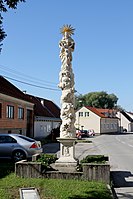Oberzögersdorf
|
Oberzögersdorf ( village ) locality cadastral community Oberzögersdorf |
||
|---|---|---|
|
|
||
| Basic data | ||
| Pole. District , state | Korneuburg (KO), Lower Austria | |
| Judicial district | Korneuburg | |
| Pole. local community | Stockerau | |
| Coordinates | 48 ° 22 '52 " N , 16 ° 8' 56" E | |
| Residents of the village | 312 (January 1, 2020) | |
| Building status | 85 ( n / a help ) | |
| Area d. KG | 6.4 km² | |
| Post Code | 2000 | |
| Statistical identification | ||
| Locality code | 04112 | |
| Cadastral parish number | 11150 | |
| Counting district / district | Oberzögersdorf (31230 VI) | |
 Plague column in Oberzögersdorf |
||
| Source: STAT : index of places ; BEV : GEONAM ; NÖGIS | ||
Oberzögersdorf is a village and a cadastral municipality of the municipality of Stockerau in Lower Austria .
geography
Oberzögersdorf is about five kilometers west of Stockerau. The cadastral municipality has an area of 640 hectares.
history
After the battle of the Lechfeld against the Hungarians on August 10, 955, the area of Oberzögersdorf was subordinated to the bishop of Passau . He was responsible for the resettlement and management of the goods. The area assigned to the bishop was made up of Schmidabach , Göllersbach and Danube . To the north, the border ran a little north of today's towns of Stetteldorf , Pettendorf , Wolfpassing and Zissersdorf .
The first written mention of Oberzögersdorf was in 1171, as "Zegendorf", in a deed of donation. In this a farm in Zegendorf was given away by Herbord von Rußbach to the Zwettl monastery . From this point on, this property and other goods acquired in the village can be found in the Zwettl Monastery property registers. The next documented owner of the village was Wikard von Zegendorf . In 1230 the spelling "Zeggendorf" was also used, later also "Zegennsdorf", "Zekersdorf" and "Zeckersdorf". In the Zwettl monastery archive, Heinrich von Kaya and Elisabeth von Kapellen are mentioned as other owners in 1299 . Chunrader der Schmidacher lived here in 1357 and Ott von Floyt in 1358 . From 1394 the village was together with the castle and the manor in Schmida in the possession of Ernst Stockhorner . This documentary mention is an indication of a castle (castle, fortress) in the village. This was on the garden plot 100/3. Today only the dams of a former moat are visible . From the village history of Schmida it is known that the site there was destroyed or burned down several times, namely in 1426 by the Hussites, in 1490 by the Hungarians and in 1529 by the Turks. Likewise, the village of Oberzögersdorf including the castle may have suffered this fate. According to Ernst Stockhorner, his son Hans is enfeoffed with the village. The Counts of Hardegg followed in 1482, Wilhelm von Zelking in 1528 and the brothers Ernst Gundarkar and Franz Herberstein in 1696. Between 1696 and 1717, Ludmilla Katharina Herberstein had Franz Herberstein's wife build a mansion in the center of the village in what is now the residential buildings at Stockerauer Strasse 15 and 17. In 1717, Count Julius IV Adam Hardegg and his wife Maria Barbara acquired "Dorf Au und Zugehre". In 1727 a Trinity column was erected in front of the manor house and a Johannes Nepomuk column about 20 meters east of it. The Trinity Column still stands unchanged in the same place today. The Nepomuk column was broken off at an angle in the base area in 1938 and later removed. The construction of a wooden chapel in 1773 is recorded in writing. In 1919 it was demolished because it was dilapidated. Today's chapel was consecrated on October 7, 1928.
![]()
The villages along the Au were already of considerable importance in the Middle Ages as a transition from the waterway to the land routes to the north. Before the Danube was regulated in the 19th century, this river consisted of a large number of channels spread across the entire Au. Some villages, including Oberzögersdorf, were close to such branches of the Danube and were unloading points for goods that were transported on the river. Even then, a fierce competition developed between the places on the Au and at the instigation of Korneuburg, the then Prince Duke Albrecht II prohibited a “Urfahr” (crossing over the Danube) and Ladstatt (unloading of ships and storage) here of goods) z. B. drift. This ban was renewed in 1451 and 1453. From the exposed location of Oberzögersdorf it is understandable that the place was repeatedly flooded by Danube floods in the past. The earlier field name “In the old village” indicates that the settlement was closer to the Au and thus lower down. Because of the wooden construction and straw roofing that was common at the time, fire usually meant a disaster for the residents. On April 22, 1559 the whole village burned down. In 1572 14 1845 17 houses and 8 barns were destroyed by fire and in 1874 half the village burned down again. On September 15, 1909, the volunteer fire brigade was founded here as well .
Infrastructure
Oberzögersdorf is connected to local public transport by a bus route and a collective taxi.
Popular culture
Oberzögersdorf plays an important role in the fictional world of Soviet Unterzögersdorf , as it represents the neighboring village of US Oberzögersdorf , which is always interested in imperialist takeover .
Buildings
Web links
Individual evidence
- ^ History of Oberzögersdorf
- ^ Soviet Unterzögersdorf: Sector 2 - derStandard.at. Retrieved March 5, 2019 (Austrian German).
- ↑ Tim Schürmann: Soviet Unterzögersdorf Sector 2 published. In: LinuxCommunity. March 9, 2009, accessed March 5, 2019 (German).

